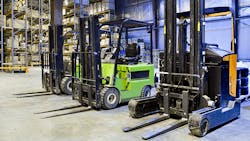Material handling, so it's said, involves the management of three things: people, processes and technology. Now, people can be quite difficult to figure out even under the best of circumstances, while processes need to be constantly tweaked as the situation requires. But technology… well, everybody seems to be enamored with the latest and greatest products, and for tech enthusiasts, there's no better place to see what's new than at ProMat 2017, North America's biggest exhibit of material handling and logistics equipment.
MHI, the trade organization that puts on ProMat, gathers demographic information from everybody who registers to attend, asking a bunch of questions to determine who's coming, what types of products they're most interested in, and how much they plan to spend on equipment in the near future. Almost half (48%) of the expected attendees are corporate/senior managers, most of them (80%) are coming to ProMat to see new products and innovations, and one-third (33%) plan to spend more than $1 million on material handling equipment over the next 18 months.
If you run the math on those projections, let's say ProMat gets 30,000 attendees this year, which is probably a conservative estimate. One third of those would be 10,000 and if each of those spends just half of the $1 million they say they're budgeted to spend, that translates into $5 billion worth of material handling equipment being purchased by the end of 2018, without even factoring in the purchasing plans of the other 20,000 attendees with smaller budgets.
And what will they be buying? The top categories for probable ProMat attendees are conveyors and sortation equipment, forklifts, and automation equipment and systems.
Forklifts and other powered vehicles are always among the most popular displays at ProMat—let's face it, the exhibits of new lift trucks is the material handling industry's equivalent of an auto show. Attendees diligently take notes on every product enhancement and new safety feature and vehicle communication capability. But what's often lost in the excitement of evaluating brand-spanking-new equipment is a very pragmatic question: How exactly is your workforce going to use the vehicles?
Seems like a no-brainer, something that any company would figure out before signing on the dotted line, but as it turns out, being able to accurately calculate the expected usage from a forklift fleet is a talent that's often lacking. And that can end up costing companies a lot of money.
Many companies, of course, finance their forklift fleets through leases rather than buying them outright, and according to Theo Rennenberg, global fleet asset manager at DLL, 89% of companies were wrong in their usage estimates at the end of a lease. "That means that nine times out of ten, material handling equipment is either over- or underutilized compared to the lease allowances," he explains. "When equipment is underutilized, it means the monthly payment is higher than it needs to be. And when it is overutilized, it means hefty overtime charges at the end of the contract."
One of the reasons companies are so far off in the usage estimates is that the operations and finance teams don't talk to each other on how to most effectively manage their fleet.
"Operations teams typically dislike overtime and request more contract hours than they need in order to avoid surprises at the end of term," Rennenberg says. "Finance teams, on the other hand, are often focused on negotiating the lowest monthly payment and are later shielded from the mid- and end-of-term results of their choices."
He suggests companies get a better handle on the total cost of operation of their fleets by asking the following questions:
- Do you pull quarterly or annual meter reads to monitor the utilization of your fleet?
- Do you regularly compare actual utilization data with lease contract allowances?
- Do you base your decisions to return equipment on the condition of the asset rather than the expiration date of the lease?
If you respond "no" to any of those questions, your company has lost sight of how best to leverage data to maximize utilization. You need to gather data from meter reads to assess exactly how your fleet is being used and maintained. Ultimately, you need your finance and operations teams to be on the same page when it comes to your fleet, he says.
And maybe it wouldn't be the worst idea to invite somebody from the finance team to accompany you to ProMat.
About the Author

Dave Blanchard
Senior Director of Content
During his career Dave Blanchard has led the editorial management of many of Endeavor Business Media's best-known brands, including IndustryWeek, EHS Today, Material Handling & Logistics, Logistics Today, Supply Chain Technology News, and Business Finance. He also serves as senior content director of the annual Safety Leadership Conference. With over 30 years of B2B media experience, Dave literally wrote the book on supply chain management, Supply Chain Management Best Practices (John Wiley & Sons, 2021), which has been translated into several languages and is currently in its third edition. He is a frequent speaker and moderator at major trade shows and conferences, and has won numerous awards for writing and editing. He is a voting member of the jury of the Logistics Hall of Fame, and is a graduate of Northern Illinois University.
